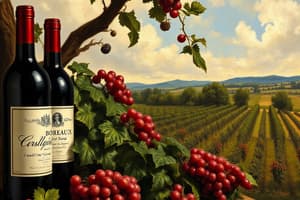Podcast
Questions and Answers
What trend is common between hot drinks and alcoholic beverages according to the video 'Beverage trends'?
What trend is common between hot drinks and alcoholic beverages according to the video 'Beverage trends'?
- Low-calorie options
- New flavors
- Standard versions of current products
- Premium versions of current products (correct)
Wines are often first classified by?
Wines are often first classified by?
color
In the United States, premium wines are named after the?
In the United States, premium wines are named after the?
grape variety
The best known sparkling wine is?
The best known sparkling wine is?
Wine is the fermented juice of freshly gathered ripe?
Wine is the fermented juice of freshly gathered ripe?
Still wines are those that have carbonation.
Still wines are those that have carbonation.
Flashcards are hidden until you start studying
Study Notes
Beverage Trends
- Premium versions of hot drinks and alcoholic beverages are currently trending, reflecting consumer demand for higher quality.
Classification of Wines
- Wines are primarily classified by color, which helps to differentiate between various types such as red, white, and rosé.
Naming of Premium Wines
- In the U.S., premium wines typically bear the name of their grape variety, indicating the principal type of grape used.
Sparkling Wine
- Champagne is the most recognized type of sparkling wine, known for its distinct characteristics and association with celebration.
Composition of Wine
- Wine is made from the fermented juice of freshly gathered and ripe grapes, which are crucial for producing quality wine.
Characteristics of Still Wines
- Still wines are defined as those without carbonation, offering a smoother drinking experience compared to sparkling wines.
Studying That Suits You
Use AI to generate personalized quizzes and flashcards to suit your learning preferences.




